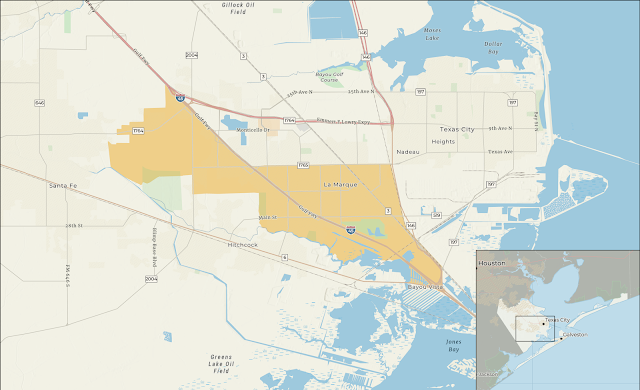Galveston County - La Marque
This week's stop along our tour of Galveston County is another town with a history nearly as old as Texas itself that owes its existence in large degree to railroads and industry. And it's yet another town with a unique cultural history that has changed its name over time. La Marque stretches through the central portion of the county's mainland portion, including more frontage along I-45 than any other city (a total of 14.3 miles), and is home to 18,030 residents as of the 2020 US Census. The city is a low-lying area with an elevation of 16' above sea level, although it does have a system of levees for hurricane protection, and barely half a square mile of the total 14.28 sq. mi. area is covered by water.
In 1838 a settlement was formed near the northern banks of Highland Bayou and initially adopted the name of Highlands. The Houston, Henderson, and Galveston Railroad laid their tracks through the community, which supported the agricultural businesses in town, most notably dairy farming. Civil War soldiers that purchased buttermilk at the stop along the route between Houston and Galveston lent the nickname of Buttermilk Station to the community. Two of the six founding families of the community were of African descent, which may have served as an enticement for several Black cowboys at the nearby Butler Ranch to live in an area known as The Settlement just to the north of the original town. A French nun who served the community as a schoolmaster and postmistress gave the city its name, however. After the US Postal Service requested a change to clear up confusion about another post office in Texas that was also named Highlands, Madam St. Ambrose came up with the name La Marque, French for "the mark", in 1886.
Early in the 20th century additional rail lines began reaching the city, including the International and Great Northern Railroad, as well as the Missouri, Kansas, and Texas Railroad. An electric railway line called the Interurban was also built by 1911, connecting Galveston to Houston and bringing new growth to La Marque. The small school that housed just 14 students when it was built in 1895 had tripled in size by 1913, and new construction was once again required. Petrochemical facilities built in neighboring Texas City fundamentally altered the economic climate of La Marque, and continued fueling population growth for several decades. By 1953 it was the largest unincorporated community in Texas, but an annexation attempt by Texas City that year led the residents to finally vote in support of incorporation. In 2015 the Texas Education Agency announced that academic and financial shortcomings of the La Marque ISD would lead to the closing of the district the following year, at which point Texas City ISD absorbed the majority of the student population and remaining campuses.



Comments
Post a Comment